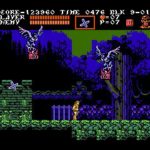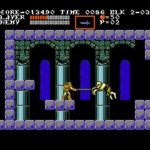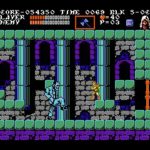Developer: Konami Publisher: Konami Release: 12/22/89 Genre: Action
For years even before I hopped on the internet I have read about the differences between the Japanese and American version of Castlevania III. I was always curious since there was no way for me to verify the information for myself. It wasn’t too uncommon for publications to mention that the Japanese version of certain games were superior to what we received. With the rise of emulation I was finally able to see for myself what all the fuss was about. In the case of Akumajou Densetsu the changes go beyond just the music. Given the choice I would definitely go with the Japanese version of the game. But let’s be clear; Castlevania III in any form is still an amazing game.
The most obvious difference comes in the music. Akumajou Densetsu used Konami’s VRC6 chip which added three additional sound channels to the NES, two square wave channels and one sawtooth wave. In layman’s terms this means a much richer sound using digital instrument samples and percussion. The difference is readily apparent and worth listening to on YouTube if you can’t find the soundtrack. Since Nintendo of America did not allow custom mappers the game was reprogrammed to use the MMC5. Given the downgrade they had to work with Konami’s engineers and musicians have done an excellent job of replicating the music. The missing instruments are noticeable but it still sounds fantastic overall.
Where the sound is different there aren’t as many graphical changes. Most of the changes stem from Nintendo’s censorship policies of the time. Naked statues and harpies have been slightly redrawn and covered up. Konami were one of the few developers able to get religious imagery past Nintendo but a few icons have been made less prominent. There are small graphical flourishes in the intro and some backgrounds were also removed as well.
The difficulty is where the most prominent changes lie next to the music. The series as a whole is known for being quite punishing and Castlevania III is near the top. Compared to the first game the addition of password saves made it tolerable. Konami made the American version of Akumajou Densetsu more difficult in a number of ways. There was a gradual curve in terms of damage. Early on every enemy deals two points of damage. By the end that increases to four, meaning you can survive four hits at most. Akumajou Densetsu has set damage ratios for every level. Not only is it more gradual it also makes your support partners more viable. Alucard and Sypha took more damage than Trevor, leaving their use to only when absolutely necessary. Now they can hang with Trevor. The same applies to Grant as well.
Ah yes, Grant. Grant was almost completely useless in the western version of the game. His stupid dagger was weak, had short range, and left you open to trading blows. Climbing walls was cool but was nothing compared to Alucard’s flight. Here Grant’s default weapon is the throwing knife. It is insanely cool to use without hearts and makes him far more viable. You still have to properly target enemies but it is more than worth it. Being able to attack from long range makes some boss battles trivial as well. I did not expect this to make much of a difference but I enjoyed using Grant so much I played through the entire game with him as my partner.
In all other respects this is still the same Castlevania III the majority of us know and love. All of the enemy and item placement is the same so that knowledge carries over. I can definitely say that I had an easier time running through this than the US version. But I do not know if I can attribute that to the lesser difficulty or the fact that I’ve played that game to death. Either way regardless of the version this is still one of the top 10 best NES games of all time.
In Closing
So why the review? This was more of a curiosity than anything else, much like my look at the Japanese version of Contra. Situations like these were rife during the 8 and 16-bit era. You would hear about them in EGM or Gamefan but never see what the fuss was about personally. It is interesting to say the least and something I would like to keep doing. Hopefully this has been helpful to someone out there.









